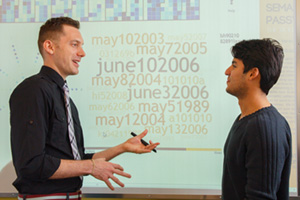UOIT research team contributes to New York Times story on password security
November 21, 2014

Pulitzer-prize winning journalist and New York Times reporter Ian Urbina has turned to a University of Ontario Institute of Technology research group to help him unlock some of the mystery behind The Secret Life of Passwords (New York Times Magazine, November 19, 2014).
For his story, over the past year Urbina consulted a multidisciplinary UOIT research team comprised of:
- Dr. Christopher Collins, Assistant Professor and Canada Research Chair in Linguistic Information Visualization, Faculty of Science
- Dr. Julie Thorpe, Assistant Professor, Faculty of Business and Information Technology
- Rafael Veras Guimarães, PhD (Computer Science) student, Faculty of Science
While the article quotes Dr. Collins, all three members of the team contributed to the New York Times Magazine story (the UOIT-related information appears in paragraphs 43 and 44). This collaboration between the university’s Visualization for Information Analysis Laboratory (vialab) and Dr. Thorpe’s Human Factors and Security group reflects the university’s support of interdisciplinary collaboration.
Urbina’s story discusses how the UOIT researchers have studied the RockYou database for common word and number patterns people typically use in passwords, and their discoveries of fascinating patterns of emotions hidden in the text.
“I think this collaboration shows the incredible potential for cross-faculty research at the University of Ontario institute of Technology,” said Dr. Collins. “It’s been the most interesting work of my career so far. We are continuing our research into both how passwords reflect our language and culture, as well as how the patterns we find impact security of crucial systems.”
The author, Ian Urbina, also indicated the New York Times is seeking additional stories about keepsake passwords (which can be emailed to urbina@nytimes.com). There is also a link on the right side of the current New York Times article for people to submit their own stories.
Related links:
- Link to Durham Now interview with Dr. Collins and Dr. Thorpe on weak passwords project driven by Rafael Veras' graduate research (courtesy of Rogers TV)
- Link to Metroland news story featuring an interview with Dr. Collins: Change your password: A lesson from Russian website hackers
- Link to the researchers’ 2014 paper Investigating the Semantic Patterns of Passwords
- Link to On the Predictability and Security of User Choice in Passwords (Dr. Julie Thorpe)
- Link to 2014 UOIT news story: How can you improve strength of your online passwords?
- Link to 2014 UOIT news story: UOIT PhD student presents paper on the meaning of passwords at security symposium



